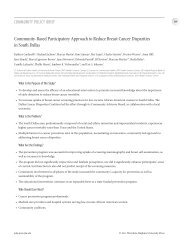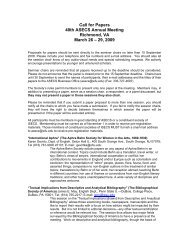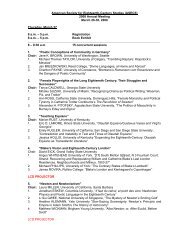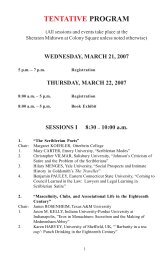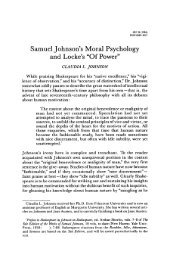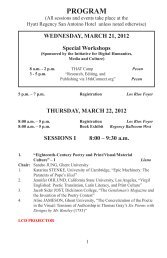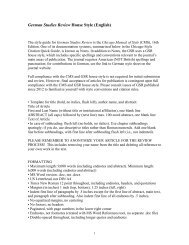Fall 2008 - The Johns Hopkins University Press
Fall 2008 - The Johns Hopkins University Press
Fall 2008 - The Johns Hopkins University Press
Create successful ePaper yourself
Turn your PDF publications into a flip-book with our unique Google optimized e-Paper software.
<strong>The</strong> Business of Speed<strong>The</strong> Hot Rod Industry in America, 1915–1990David N. LucskoSince the mass production of Henry Ford’s Model T, carenthusiasts have been redesigning, rebuilding, and reengineeringtheir vehicles for increased speed and technical efficiency.<strong>The</strong>y purchase aftermarket parts, reconstruct engines,and enhance body designs, all in an effort to personalize andimprove their vehicles. Why do these car enthusiasts modifytheir cars and where do they get their aftermarket parts?Here, David N. Lucsko provides the first scholarly historyof America’s hot rod business.Lucsko examines the evolution of performance tuningthrough the lens of the $34-billion speed equipment industrythat supports it. As early as 1910, dozens of small shopsacross the United States designed, manufactured, and soldadd-on parts to consumers eager to employ new technologiesas they tinkered with their cars. Operating for muchof the twentieth century in the shadow of the Big Threeautomobile manufacturers—General Motors, Ford, andChrysler—these businesses grew at an impressive rate, supplyingyoung and old hot rodders with thousands of performance-boostinggadgets.Lucsko offers a rich and heretofore untold account of theculture and technology of the high-performance automotiveaftermarket in the United States, offering a fresh perspectiveon the history of the automobile in America.“It is very well written, thoroughly researched, and documents animportant part of automotive history in the U.S. that hitherto hasreceived scant treatment from academic historians . . . <strong>The</strong> authorhas a strong understanding of the hot rod industry, its various industrialleaders, and is very comfortable writing about the technologiesthemselves.”—Larry D. Lankton, Michigan Technological <strong>University</strong>David N. LucSKO is managing editor of Technology and Cultureand an instructor of technological history at the <strong>University</strong>of Detroit Mercy.Eat My DustEarly Women MotoristsGeorgine Clarsen<strong>The</strong> history of the automobilewould be incompletewithout considering the impactof the car on the livesand careers of women in theearliest decades of the twentiethcentury. Illuminatingthe relationship betweenwomen and cars with casestudies from across the globe,Eat My Dust challenges thereceived wisdom that menembraced automobile technologymore naturally thandid women.Georgine Clarsen highlights the personal stories of womenfrom the United States, Britain, Australia, and colonialAfrica from the early days of motoring until 1930. Shenotes the different ways in which these women embracedautomobile technology in their national and culturalcontext. As mechanics and taxi drivers—like AustralianAlice Anderson and Brit Sheila O’Neil—and long-distanceadventurers and political activists—like South AfricansMargaret Belcher and Ellen Budgell and American suffragistSara Bard Field—women sought to define the technologyin their own terms and according to their own needs. <strong>The</strong>ychallenged traditional notions of femininity through theirlove of cars and proved they were articulate, confident, andmechanically savvy motorists in their own right.More than new chapters in automobile history, these storieslocate women motorists within twentieth-century debatesabout class, gender, sexuality, race, and nation.Georgine ClARSEN is a senior lecturer in the School of Historyand Politics at the <strong>University</strong> of Wollongong.<strong>The</strong> <strong>Johns</strong> <strong>Hopkins</strong> <strong>University</strong> Studies in Historical and Political Science<strong>Johns</strong> <strong>Hopkins</strong> Studies in the History of TechnologyMerritt Roe Smith, Series EditorNovember 384 pages 6.125 x 9¼ 25 halftones978-0-8018-8990-5 0-8018-8990-1 $50.00(s) / £27.00 hcHistory of TechnologyOctober 224 pages 6 x 9 16 halftones, 2 line drawings978-0-8018-8465-8 0-8018-8465-9 $50.00(s) / £27.00 hcHistory of Technology / Gender StudiesTHE JOHNS HOPKINS UNIVERSITY PRESS www.press.jhu.edu 36



